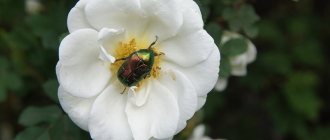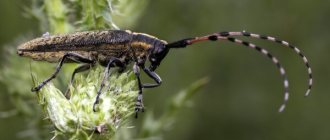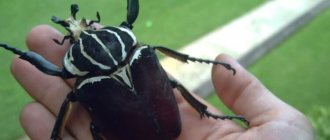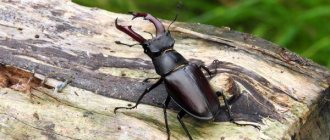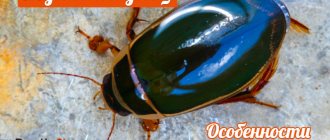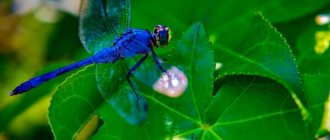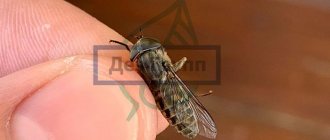Bronze beetle larvae and May beetle larvae, what is the difference? I didn't know. I think that many people do not know, but the cockchafer larva is an enemy, and the bronze beetle larva is a friend.
2012, potatoes were harvested, from 5 sq. m turned out to be 90 kg of potatoes . When harvesting potatoes, I collected a lot of fatty larvae, but examining each tuber, I did not find any damage to the potatoes. I've heard a lot that the larvae of the beetle (Chafer beetle) eat potato tubers. But they didn't touch my potatoes. I don’t use chemistry like “Prestige”, I don’t use any chemistry. Then why weren't they touching my potatoes?
I addressed this question to Alexander Viktorovich Timokhov by e-mail. ( MSU named after M.V. Lomonosov, Faculty of Biology, Department of Entomology, since December 1, 1995. Candidate of Biological Sciences since 1998).
I sent him photos of the larvae
Bronze beetle larvae
.
This is what A.V. Timokhov answered me: “Judging by what I see in the photo, these are larvae of the bronze beetle.
They have never been serious pests. More or less noticeable damage can be expected if only they occur in approximately the same quantities as in the first photo per 1 sq. meter. And even then......"
Taking my word for it, I didn’t think about it anymore. Moreover, you don’t often see the cockchafer here, but bronze beetles fly all summer.
This is a bronze, photo from the Internet.
This is a cockchafer. Photo from the Internet.
All my beds are mulched with fresh grass. Active mulch. Intensive beds.
If there is not enough grass, then I mulch with old leaves. Constantly, especially when harvesting potatoes, I found such larvae in large numbers, but they did not touch the potatoes. The entomologist was right!
I used to give all the larvae that I found to the birds.
Time has passed.
In the fall of 2014, my son and I put compost in boxes. (For what - it is written HERE ). My son noticed the very good quality of the compost. And, surprisingly, the best compost was where the larvae were swarming! It wasn't even compost anymore! Most of all, it looked like granular black soil! We selected the larvae by hand and gave them to the birds.
Another year has passed. In the fall of 2015, my son’s girlfriend helped me move the compost. This time, she noticed that where there are a lot of larvae, the compost is of excellent quality! And I remembered my son’s words last year….
That's it, young people notice everything when they want! And I? Sclerosis, you need to write it down...
We selected the larvae and poured them into a box with fresh compost (the box was filled in 2015). I don't know if they will survive there in the winter or not, but I hope they will. Starting in the spring, I will release bronze larvae there.
Conclusion:
Description and features of bronze
Metallic bronze is called because of its color. It is black, but the light is refracted, giving rainbow reflections. They are metal. Sometimes, in the photo, the bronze beetle looks like gasoline spilled in a puddle.
This reflection of light rays is due to the uneven, porous microstructure of the elytra and integument of the insect’s head. Its other features include:
- body length from 1 to 3 centimeters
- body width from 8 to 11 millimeters
- oval body shape
- rigid elytra that do not open in flight, which distinguishes the heroine of the article from the cockchafer
- the presence of side holes in the rigid elytra for extending transparent wings
Bronze beetles are very active beetles
Since the bronze beetle does not need to open or raise its elytra before flying, the beetle instantly rises into the air. It's easier for the insect there than for most of its relatives. Open elytra slow down flight. Bronzovkas move quickly and over long distances.
On the ground, or more precisely on plants, bronzes are slow and inactive. A beetle can sit on one flower for about 2 weeks. During precipitation, the insect slides down, burrowing into the ground.
Insects of the genus love warm, sunny weather. This is when beetles are most active. After sitting on roses, the bronze beetle can fly to another plant with the speed of a bumblebee. The flight is fast, but the insect is clumsy in it. Sometimes beetles do not have time to fly around people. After the collision, the bronze birds fall on their backs, turning over with difficulty and taking off again.
How to catch chub using a cockchafer?
But for fishermen, May beetles are a real value, because they can be used to catch some species of fish. Catching chub with a cockchafer occurs as follows. We cast the fishing rod, lower the line and wait for the bite. The bait should not move...
You will quickly feel the bite and hook. But don’t rush to pull out the chub, let him walk with the bait. Chub is a good catch using a cockchafer wobbler. The cockchafer wobbler is an artificial but effective bait.
Types of bronze
There are 5 subspecies of Russian Bronzeworts. Each has several forms, differing in color. A defining feature is also the presence or absence of fluff on the body. In general, there are about 20 items. There are approximately 4 thousand species of bronzebacks on the planet. Most of them are tropical residents.
Bronzovkas of the temperate climate zone include:
1. Smooth. It reaches 3 centimeters in length, looks green, sometimes with blue and red reflections. The beetle is found near old trees, choosing large trunks.
The smooth bronze beetle can be easily distinguished from other beetles by the metallic sheen of its shell.
2. Smelly. This is no longer a green bronze beetle , but a black one with white markings. Representatives of the species live in the southern regions of Russia and neighboring countries. The body length of the bronze does not exceed 1.3 centimeters. The body of young individuals is covered with white hairs and has a strong smell.
Stinking bronze beetle
3. Marble. The length of the insect is 2.7 centimeters. The name of the species is associated with the black-bronze color, which is decorated with uneven, whitish lines. They resemble veins on black marble.
The photo shows a marble bronze
4. Golden bronze beetle . From the name it is clear that the elytra of the insect shine with yellow metal. The length of the beetle does not exceed 2.3 centimeters. Representatives of the golden species prefer to settle in gardens and vegetable gardens, choosing regions with black soil.
The golden bronze is distinguished by the golden sheen of its shell
Bronze beetles and cockchafers are often found there at the same time . In the latter, unlike the heroine of the article, not only do the elytra move apart, but the metallic reflection is not expressed.
Outside the country, in the tropics, there lives, for example, the Congolese bronze. It is colored black, yellow, orange-red. The beetle is large, lives in bushes and trees, feeding on their fruits, leaves, and flowers.
Tropical bronze species have a short life cycle. So, Congo beetles live only 2 months.
Congolese bronzes live in tropical forests
What does a cockchafer look like?
An adult insect reaches a length of 3.5 centimeters. The body of the cockchafer has an elongated oval shape and is black or brown in color. The beetle has 2 double wings, which are attached to the chest. There are 3 pairs of legs. The body of the cockchafer consists of a head, chest and abdomen, which are covered with protective chitin. The abdomen consists of 8 segments, the chest - of 3 segments.
The elytra protect the hind wings. The head is small. May beetles in down jackets - this is exactly the picture that appears if you look closely at the insect. Its entire body is covered with numerous hairs.
The May Khrushchev has excellent eyesight thanks to its bulging eyes. Each eye consists of thousands of simple ocelli. There is one pair of antennae that perform an olfactory function. The cockchafer has a gnawing type of mouth.
Beetle nutrition
What the bronze beetle eats depends on its species. Representatives of the smooth one love overripe fruits, so they do not damage the plantings. On the contrary, beetles act as a kind of orderlies, cleaning up already missing berries and fruits.
The Stinking Bronzewort eats pollen, which is basically harmless. So the beetles even contribute to pollination. However, stinky individuals also have a second favorite product - plant roots. These insects harm the plantings.
The marbled bronze settles in the forest-steppe zone, choosing plantings with an abundance of rotten trunks. Juice flows out of them, which the beetle feeds on. Therefore, the marbled appearance is harmless for agriculture.
The golden bronze likes to eat imported plants, so it is a malicious pest, destroying the crop, so to speak, on the vine.
The bronzer's diet also depends on its condition. Larvae, for example, eat only dead plants. They switch to living bronze beetles already in the beetle stage.
Iodine from cockchafer larvae. How to get rid of cockchafer larvae on strawberries
Methods of combating furrow weeds depend on their number and the preferences of the gardener. Strawberries can be treated with chemicals 30-60 days after picking the berries. To protect crops from pests, the following methods are used:
- mechanical - physical destruction of beetle larvae;
- chemical - the use of insecticides for soil treatment;
- folk - treating beds with infusions or growing plants nearby to repel pests.
Mechanical methods of protection
Plastic bottle for catching Khrushchev
The fight against cockchafer larvae on strawberries begins with the mechanical destruction of detected pests during planting and caring for the crop. When the first furrows are discovered, they dig up the earth along the bushes to a depth of 40-50 cm. If more than 4 pests are identified, it is necessary to take urgent control measures using folk or chemical methods.
It would be a good idea to collect adult beetles, because any of the females can lay eggs on the strawberry patch. In the early morning, insects are shaken off garden plants onto the canvas and destroyed. An effective way to catch cockchafers is to construct light traps:
- Trim the top of a 5-quart clear plastic container.
- Spread it inside with something sticky (grease, grease, etc.).
- Place a flashlight on the bottom.
- Leave overnight in the area where the beetles were spotted.
- In the morning, scald the trap with the caught insects with boiling water.
- If necessary, repeat the procedure.
An excellent preventive measure against pests is deep plowing (digging) of the site in autumn. The lower layers of earth with larvae rise to the surface when cultivating the earth. Birds eat furrows with pleasure; some of the parasites die under the influence of low air temperatures.
Insecticides to combat beetleworm
Chemical preparations for Khrushchev
If there is a large accumulation of furrows in the soil, it is necessary to immediately begin treating the soil with insecticides. Chemical preparations are good because the death of pests occurs within 24 hours. The fight against the cockchafer larva is carried out using one of the following means:
| Name (active substances) | Operating principle | Application |
| Karbofos solution (organophosphorus compound) | Paralyzes the digestive system. |
|
| Antichrusch (imidacloprid, bifenthrin) | Affects the insect's nervous system. |
|
| Biological product Nemabakt (nematodes infected with symbiotic bacteria) | Microorganisms settle in the body of the larvae and eat them from the inside. |
|
| Actara (thiamethoxam) | Contact-intestinal:
|
|
| Bazudin (Dazinon) |
|
Reproduction and lifespan
Bronzebirds of the temperate climate zone are active from late spring for a maximum of 4.5 months. However, the total life cycle is 2 years. They start from the egg stage. It is yellowish, deposited in compost heaps, anthills, and black soil.
Then the larva of the bronze beetle . They hatch from eggs after 2 weeks. The larvae are initially white, then molt twice and turn yellow, curling into a crescent shape. This occurs at a length of 6 cm.
Bronze larva
The beetle experiences the larval stage in its original shelter, for example, an anthill. Its inhabitants are indifferent to bronco babies, but badgers and foxes are not. Predators periodically tear apart anthills, feasting on beetle larvae.
The meal is possible until the first cold weather. Afterwards, the bronzes descend below the frost line. There the larvae pupate, secreting a sticky mass. Her bronzes are mixed with dust and earth.
The last stage is the beetle. It emerges from the pupa towards the end of spring. Now birds of prey pose a danger to the insect. The hairy bronze beetle and other representatives of the genus are a tasty morsel for rooks, jackdaws and rollers. Black-fronted shrikes, jays and orioles also hunt for beetles.
Bronzovka shaggy
Bronze beetle larvae are not enemies.
Upon closer examination of the compost heap, we noticed that earthworms live en masse in the lower layer, apparently feeding there. But bronze larvae can be found in any layer of compost. They perfectly process plant residues. After processing by the larvae, the compost looks like granulated coffee, only black. If the larva gets into the garden bed (I didn’t notice it, or the beetle laid eggs), then the larva does not touch the roots of the plants, tubers, the larva feeds on mulch and produces compost directly on the garden bed.
Internet confirms this:
“...The larva of the bronze beetle eats continuously and turns dead leaves and stems, already destroyed by rotting, into powder. The veins would remain intact for a long time in the rotting leaves. The larva also eats these slowly rotting remains: with its strong jaws it splits them into fibers and then gnaws them. In her intestines they turn into dough, quite suitable for fertilizing the soil. One of the most active producers of black soil is the bronze larva” (Jean-Henri Fabre “The Life of Insects. Stories of an Entomologist”).
“….Bronze larvae are often found in compost. They are very similar to Khrushchev, you won’t be able to tell the difference right away. If a larva gets into the garden, it, of course, can damage the plantings if there is no food for it that is familiar to it. But Khrushchev larvae are not “scavengers”: they prefer to feed on fresh plants...”
The benefits and harms of bronze
What are the harm and benefits of a beetle? Bronzewort in its larval stage does no damage. On the contrary, voracious larvae loosen the soil and accelerate the processing of dead plants, helping to fertilize the soil.
is a different matter . how to fight it , since the insect eats flowers:
- roses
- peony
- phlox
- iris
- fruit and berry plants with light buds
Beetles sometimes eat flowers, along with peduncles and shoots. However, as was written earlier, only some types of bronzes are dangerous for gardens and vegetable gardens. They are fighting with them.
Bronzovka - a pest for roses
Folk methods of combating the cockchafer and larvae
In order to successfully fight the cockchafer, you need to know how it behaves:
- In the early morning, beetles are usually inactive and can be easily shaken off the trees onto a specially laid out litter. The collected pests are then destroyed.
- In the dark, beetles flock to the light, so they can be collected in light traps. It must be prepared in advance - any shallow container is coated with a sticky substance and a light bulb is placed in the middle. In the evening the trap is placed outside. Not only cockchafers stick to such traps, but also cutworm butterflies, whose caterpillars destroy cabbage, beets and green tomatoes.
- Starlings also will not refuse a fleshy delicacy, so a birdhouse on the site is necessary.
- The ground under the trees is sown with white clover or lupine. These plants enrich the soil with nitrogen, which repels larvae.
- The ground under the plantings is sprayed with an infusion of onion peels or a pink solution of potassium permanganate.
Ordinary hedgehogs are big fans of larvae. If a thorny family settles nearby, the pest population will begin to decline rapidly.
Larvae are also collected manually while digging the soil.
Secrets of the fight
In fact, the fight against the Alenka hairy beetle is difficult and practically ineffective. Judge for yourself, the flight and attack of the beetle occurs during the flowering period of the garden, and in order to exterminate the insect, many recommend spraying flowering trees and shrubs with insecticides. But by killing only the beetle on which a drop of the poisonous solution falls, you can also destroy pollinating insects that are very useful and necessary for trees and shrubs, each individual of which is simply worth its weight in gold in a garden plot. The poisoned bees will die, and in place of the fallen beetle of Alenka Mokhnataya, a new beetle will fly in, living, for example, in a neighbor’s dacha, and will again continue to destroy flowering trees. But you shouldn’t give up either. Experienced gardeners do not stop fighting insect pests. They are coming up with more and more new ways to at least slightly reduce the pest population in their garden plot. We will talk about methods of combating pest beetle larvae below.
- Insecticide Calypso. It is known that the larva of Alenka Mohnatay lives in the top layer of soil, preferring the holes of fruit trees, strawberry beds and areas with bushes, well fertilized with rotted manure. In early spring, long before your garden blooms, spray, or better yet, water this particular soil with an insecticide. It is still cold, and the bees are not flying, but the larvae in the pupae are already waking up. So, water the areas where overwintering beetles are likely to accumulate with an insecticide solution. The drug "Calypso" has proven itself well, judging by the manufacturer's mark, it does not affect bees. You can try “Regent” or “Force”, which destroy the larvae of the cockchafer. Who knows, maybe the larva of Alenka Mohnatay will die after such treatment.
- Garden sanitization and digging. We remember that the larvae live and develop in humus, manure and compost heaps, as well as on dry and rotten branches thrown in the corners of the garden and simply forgotten. Sanitize the dacha area, remove all dry and rotten sticks and branches, uproot old and unnecessary stumps, remove leaf litter that has been lying near the fences for years, collect and take it outside the area, or better yet, burn the rotten remains of fruits and vegetables. After clearing the clogged area, dig up the area. Autumn digging will help turn the larval pupae along with the soil onto the soil surface, where, under the influence of winter frosts, the larvae will die. When digging in the spring, it is simply advisable to collect the larvae or other pupa and burn them.
- Use of biological products. “Boverin” and “Pecilomine”, microbiological, entomopathogenic fungal preparations, can limit the increasing number of pest beetles. In the fight against Alenka Mohnata with these biological products, a positive result was noted in the defeat of both adults and larvae by facultative parasites contained in the drug. Long-term contact of entomopathogenic fungi with beetle individuals led to the death of 80% of the Alenka Mohnata population provided for research. Sharp fluctuations in temperature and soil moisture worsen the condition of pest beetles, which caused massive damage to the studied population by entopathogenic fungi. Laboratory studies have shown that during the period of mass burrowing of beetles into the ground, it is necessary to treat with these particular biological preparations. Since during one season, only one generation of Alenka Mohnata beetles develops, then only one treatment with a biological product is needed. The components of the preparations are non-toxic and harmless to bees or other pollinating insects in your garden. Scientists have proven that treatment with biological products is a promising method of protecting perennial flowering and fruiting plants from the pest Alenka Mohnataya at all stages of pest development, from the larva to the adult.
- Insecticides containing diazinon. In early spring, even before fruit flowers bloom on trees and shrubs, spray the ground with preparations such as “Prestige” and “Medvetox”. Having a direct destructive effect on the larvae of the cockchafer, mole cricket, nematode, onion and carrot flies, the drugs may also affect the larva of Alenka Mohnatay. Be that as it may, by spraying the surface soil under trees and shrubs, you will significantly reduce the number of insect pests in your garden. It is a good idea to incorporate the insecticide solution into the soil to a shallow depth. Adult beetles burrow into the soil, into the top layer, to spend the night, in rain or cold, where they absorb poisoned humus. Both the beetle and the larva will certainly die after eating humus poisoned by the insecticide.
- Use of Tefluthrin. The root zone of plants treated with Tefluthrin is a good bait for the death of larvae. The components of the drug, spreading over the surface of the earth near the root system of a tree, shrub or vegetable plant, create a gas shell, penetrating into which any insect will inevitably die by inhaling the poisonous gas.
- Construction of birdhouses. Birds have always been considered forest healers, saving perennial trees from damage by various insects. Why not attract birds to fight both with adult Alenka Mohnatay and with larvae. Build birdhouses, place feeders, and the feathered forest healers will help you.
- Pets and birds. Quite often you can find domesticated chickens rowing in the garden in rural areas. Release poultry onto your property and they will loosen your beds, pick out almost all the larvae of insect pests and loosen the soil. Cats and dogs can be good helpers. Take your pets with you to the dacha; they, too, would not mind eating a fat and thick worm.
- Use of protective plants. Try to sow the soil in places where pest larvae may accumulate with plants that have bitter roots and stems, as well as a pungent odor. Planting horseradish, tansy, dandelion, mustard, wormwood, garlic, and hot pepper may block the migration route of the larvae.
- Equipment for beetle traps. Build mini traps, install blue containers filled with water, lay out all kinds of bait, shake off sleeping beetles onto spread plastic films before waking up, collect by hand, spray water infusions of protective plants, apply insecticides to the soil - any action, although not completely exterminating the insects, pest, but will still reduce its number. And if there are no beetles, there will be no larvae. And the damage caused to the garden plot will be minimized.
The larvae of Alenka Mohnatay are truly a real evil on any personal plot, so you shouldn’t wait for trees to bloom and adults to appear; start taking care of the safety of your future harvest in the fall and early spring.
Join our Facebook group
Chemical control agents
All of the above control measures are effective only with a small number of pests. If your plantings are rapidly dying, it’s time to turn to chemicals to get rid of the cockchafer. How to use them, and what drugs they include:
"Zemlin."
Refers to insecticides of contact and intestinal action. The active ingredient is diazinon. It affects soil pests, maintaining its effect for two months. It is applied to the soil during planting and in the fall for preventive purposes after harvesting.
"Nemabact."
The drug is biological and completely safe for use. It populates the soil with a predatory nematode and special bacteria, which enter the larvae’s body through the respiratory organs and destroy it. Then the nematode leaves the empty shell and goes in search of new victims. In winter, these worms fall into suspended animation, and with the arrival of warmth they come to life again and begin to feed. The product is diluted with water and applied to pre-moistened and loosened soil.
"Start."
Analogue of "Zemlin" based on diazinon. The drug is available in the form of granules, which increase its duration of action. It is applied to the soil early in the spring and is effective throughout the season.
"Aktara".
A product containing the active ingredient thiamethoxam. A day after application to the soil, all pests die. Can be used at any time of the year and in any weather. High humidity is not an obstacle and does not affect its properties.
"Anti-Khrushch."
Available in the form of a concentrated emulsion with two active ingredients - imidacloprid and bifenthrin. The product has a prolonged action, high efficiency, is resistant to precipitation and is not addictive. It affects both adults and larvae.
"Bazudin."
The drug based on diazinon has a long-lasting effect and is economical: a 30-gram sachet is enough to treat 20 square meters. The product is mixed with sand in a liter jar and added a little under each bush or with a tuber when planting.
"Vallar."
The drug is diluted in water and the roots of the seedling are dipped into it before planting. Thus, the larva quickly dies when eating the roots.
To effectively combat the cockchafer, it is necessary to use a set of plant protection measures. It is even better to combine protective measures with preventive ones. Thus, there is a high probability of bringing larvae onto the site along with manure, because in the first year of life they feed on unrotted organic matter. Before adding manure to the beds, it is necessary to sift it to prevent pests from entering. If the beetleworm is found in neighboring areas, it is better to replace the manure with compost or liquid nettle fertilizer, which is guaranteed to be free of larvae. Compliance with all these measures will help protect your crops and preserve the harvest.
